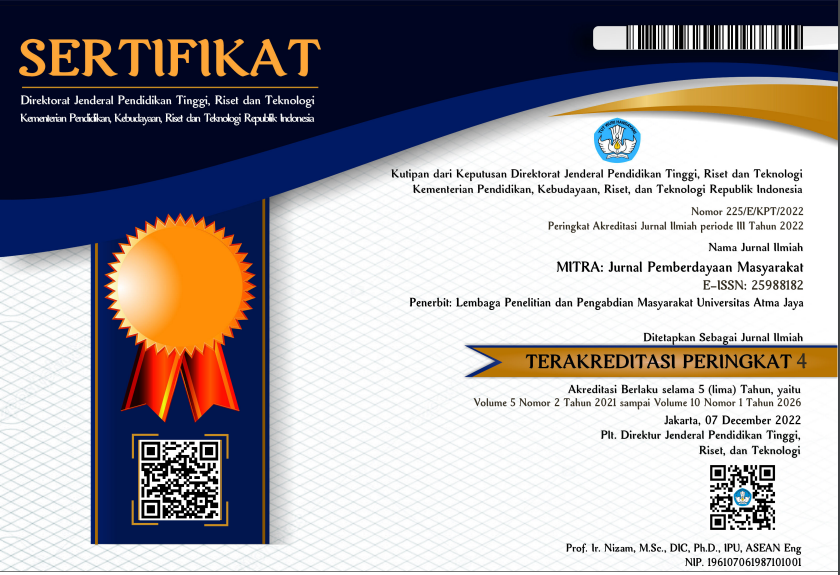Educational Efforts to Improve Public Awareness about Greening and Healthy Lifestyle in Urban Areas
DOI:
https://doi.org/10.25170/mitra.v6i1.2947Keywords:
healthy lifestyles, hydroponics, parasitic contamination, greening, probioticsAbstract
Public awareness and concern about greening and healthy lifestyles in preserving the environment and improving health status are crucial despite the covid-19 pandemic. One approach to deal with this issue is by spreading the information and taking promotive actions which aim to increase public awareness of the importance of greening and healthy lifestyles in their daily lives. Various online educational activities for communities are needed to increase their knowledge and concern. In this regard, the Daerah Binaan (DABIN) unit and the Hazard Analysis and Critical Control Point (HACCP) of the Faculty of Medicine and Health Sciences at Atma Jaya Catholic University of Indonesia held a SEHATI challenge and an educational seminar "Evergreen: Go Green, Go Healthy." One of the topics raised through this online seminar was "Urban Farming in the Pandemic Period: Economical and Ecological," which discusses various benefits of growing hydroponic vegetables. In addition, the topic of promoting a healthy lifestyle includes the proper processing of fresh vegetables to avoid parasitic contamination and a healthy breakfast with the consumption of probiotics. As many as nine and 198 people attended the challenge competition and seminar. A pre-test and a post-test were held before and after the seminar to determine the participants' knowledge. The result showed that the participants' knowledge increased between 15% to 38%. The efforts to deliver periodic education about greening and healthy lifestyles action will continue to be carried out by DABIN and HACCP. These efforts aim to improve public awareness about the importance of this topic, reduce global warming, and improve the health status of an area.
References
https://www.ncbi.nlm.nih.gov/pmc/articles/PMC7127876/.
El Said Said, D. (2012). Detection of parasites in commonly consumed raw vegetables. Alexandria Journal of Medicine, 48(4), 345–352. https://doi.org/10.1016/j.ajme.2012.05.005.
Indonesia, A. P. J. I. (2021). Laporan survei internet APJJI. Asosiasi penyelenggara Jasa internet Indonesia. https://apjii.or.id/content/read/39/410/Hasil-Survei-Penetrasidan-Perilaku-Pengguna-Internet-Indonesia-2018.
Ischak, M., & Burhannudinnur, M. (2020). Upaya meningkatkan pengetahuan dan kesadaran masyarakat tentang pentingnya ruang terbuka hijau di permukiman padat. Jurnal AKAL: Abdimas dan Kearifan Lokal, 1(1), 6–19.
https://doi.org/10.25105/akal.v1i1.7746.
Juhola, S. K. (2019). Responsibility for climate change adaptation. Wires Climate Change, 10(5), 1–13. https://doi.org/10.1002/wcc.608.
Juwita, E. P., Budimansyah, D., & Nurbayani, S. (2015). Peran media sosial terhadap gaya hidup siswa. SOSIETAS: Jurnal Pendidikan Sosiologi, 5(1) 17–24. https://doi.org/10.17509/sosietas.v5i1.1513.
Kusumaningtyas, D., Agustasari, K. I., Fransiska, R. D., Indahwati, L., & Hastuti, N. A. R. (2021). Sosialisasi video edukasi dalam rangka menjaga kesehatan anak pada siswa sekolah dasar secara daring. Publikasi Pendidikan, 11(3), 221–226. https://ojs.unm.ac.id/pubpend/article/view/21376.
Lüttge, U., & Buckeridge, M. (2020). Trees: Structure and function and the challenges of urbanization. Trees, 34(4), 1-2. https://doi.org/10.1007/s00468-020-01964-1.
Masi, L., Sudia, M., Salim, S., Prajono, R., & Sarina, S. (2020). Pemanfaatan media sosial sebagai sarana komunikasi dalam pencegahan meluasnya wabah covid-19 di kalangan pelajar. Humanism: Jurnal Pengabdian Masyarakat, 1(3), 219 –228.
Muhyiddin, & Nugroho, H. (2021). A Year of Covid-19: A long road to recovery and acceleration of Indonesia's development. The Indonesian Journal of Development Planning, 5(1), 1–19. doi: 10.36574/jpp.v5i1.
Organization, F. A. (2016). Building greener cities: Nine benefits of urban trees. Food and Agriculture Organization of the United Nations. Retrieved September 13, 2021, from http://www.fao.org/zhc/detail-events/en/c/454543/.
PPID. (2020). Hutan dan deforestasi Indonesia tahun 2019. Retrieved August 12, 2021,from http://ppid.menlhk.go.id/berita_foto/browse/2295.
Pradono, J., & Sulistyowati, N. (2014). Correlation between education level, knowledge of environmental health, healthy behavior with health status, Correlation study on people aged 10–24 in Jakarta Pusat. Buletin Penelitian Sistem Kesehatan, 17(1), 89–95.
Rasmikayati, E., et. al (2019). Peningkatan pengetahuan dan ketertarikan remaja pada hidroponik berbasis organik. Jurnal Pengabdian kepada Masyarakat, 3(6), 147–151
.
Roidah, I. S. (2014). Pemanfaatan lahan dengan menggunakan sistem hidroponik. Jurnal Bonorowo, 1(2), 43-49. https://doi.org/10.36563/bonorowo.v1i2.14.
Downloads
Published
How to Cite
Issue
Section
License
This license allows reusers to distribute, remix, adapt, and build upon the material in any medium or format for noncommercial purposes only, and only so long as attribution is given to the creator. If you remix, adapt, or build upon the material, you must license the modified material under identical terms.







_.jpeg)




.png)
2.png)
.png)
.png)



